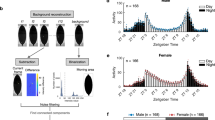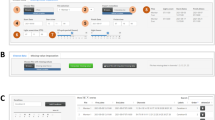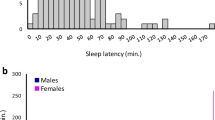Abstract
In the past decade, Drosophila has emerged as an ideal model organism for studying the genetic components of sleep as well as its regulation and functions. In fruit flies, sleep can be conveniently estimated by measuring the locomotor activity of the flies using techniques and instruments adapted from the field of circadian behavior. However, proper analysis of sleep requires degrees of spatial and temporal resolution higher than is needed by circadian scientists, as well as different algorithms and software for data analysis. Here I describe how to perform sleep experiments in flies using techniques and software (pySolo and pySolo-Video) previously developed in my laboratory. I focus on computer-assisted video tracking to monitor fly activity. I explain how to plan a sleep analysis experiment that covers the basic aspects of sleep, how to prepare the necessary equipment and how to analyze the data. By using this protocol, a typical sleep analysis experiment can be completed in 5–7 d.
This is a preview of subscription content, access via your institution
Access options
Subscribe to this journal
Receive 12 print issues and online access
$259.00 per year
only $21.58 per issue
Buy this article
- Purchase on Springer Link
- Instant access to full article PDF
Prices may be subject to local taxes which are calculated during checkout




Similar content being viewed by others
References
Roberts, S.K. 'Clock' controlled activity rhythms in the fruit fly. Science 124, 172 (1956).
Campbell, S.S. & Tobler, I. Animal sleep: a review of sleep duration across phylogeny. Neurosci. Biobehav. Rev. 8, 269–300 (1984).
Hendricks, J.C. et al. Rest in Drosophila is a sleep-like state. Neuron 25, 129–138 (2000).
Shaw, P.J., Cirelli, C., Greenspan, R.J. & Tononi, G. Correlates of sleep and waking in Drosophila melanogaster. Science 287, 1834–1837 (2000).
Graves, L.A., Heller, E.A., Pack, A.I. & Abel, T. Sleep deprivation selectively impairs memory consolidation for contextual fear conditioning. Learn. Mem. 10, 168–176 (2003).
Li, X., Yu, F. & Guo, A. Sleep deprivation specifically impairs short-term olfactory memory in Drosophila. Sleep 32, 1417–1424 (2009).
Gilestro, G.F., Tononi, G. & Cirelli, C. Widespread changes in synaptic markers as a function of sleep and wakefulness in Drosophila. Science 324, 109–112 (2009).
Ganguly-Fitzgerald, I., Donlea, J. & Shaw, P.J. Waking experience affects sleep need in Drosophila. Science 313, 1775–1781 (2006).
Nitz, D.A., van Swinderen, B., Tononi, G. & Greenspan, R.J. Electrophysiological correlates of rest and activity in Drosophila melanogaster. Curr. Biol. 12, 1934–1940 (2002).
Pfeiffenberger, C., Lear, B.C., Keegan, K.P. & Allada, R. Locomotor activity level monitoring using the Drosophila Activity Monitoring (DAM) system. Cold Spring Harb. Protoc. published online, doi:10.1101/pdb.prot5518 (1 November 2010).
Konopka, R.J. & Benzer, S. Clock mutants of Drosophila melanogaster. Proc. Natl. Acad. Sci. USA 68, 2112–2116 (1971).
Rosato, E. & Kyriacou, C.P. Analysis of locomotor activity rhythms in Drosophila. Nat. Protoc. 1, 559–568 (2006).
Zimmerman, J.E., Raizen, D.M., Maycock, M.H., Maislin, G. & Pack, A.I. A video method to study Drosophila sleep. Sleep 31, 1587–1598 (2008).
Gilestro, G.F. & Cirelli, C. pySolo: a complete suite for sleep analysis in Drosophila. Bioinformatics 25, 1466–1467 (2009).
Chiu, J.C., Low, K.H., Pike, D.H., Yildirim, E. & Edery, I. Assaying locomotor activity to study circadian rhythms and sleep parameters in Drosophila. J. Vis. Exp. published online, doi:10.3791/2157 (28 September 2010).
Huber, R. et al. Sleep homeostasis in Drosophila melanogaster. Sleep 27, 628–639 (2004).
Keene, A.C. et al. Clock and cycle limit starvation-induced sleep loss in Drosophila. Curr. Biol. 20, 1209–1215 (2010).
Shaw, P.J., Tononi, G., Greenspan, R.J. & Robinson, D.F. Stress response genes protect against lethal effects of sleep deprivation in Drosophila. Nature 417, 287–291 (2002).
Shimizu, H. et al. Drosophila ATF-2 regulates sleep and locomotor activity in pacemaker neurons. Mol. Cell Biol. 28, 6278–6289 (2008).
Branson, K., Robie, A.A., Bender, J., Perona, P. & Dickinson, M.H. High-throughput ethomics in large groups of Drosophila. Nat. Methods 6, 451–457 (2009).
Straw, A.D. & Dickinson, M.H. Motmot, an open-source toolkit for realtime video acquisition and analysis. Source Code Biol. Med. 4, 5 (2009).
Catterson, J.H. et al. Dietary modulation of Drosophila sleep-wake behaviour. PLoS ONE 5, e12062 (2010).
Crocker, A. & Sehgal, A. Octopamine regulates sleep in Drosophila through protein kinase A-dependent mechanisms. J. Neurosci. 28, 9377–9385 (2008).
Hendricks, J.C. et al. Gender dimorphism in the role of cycle (BMAL1) in rest, rest regulation, and longevity in Drosophila melanogaster. J. Biol. Rhythms 18, 12–25 (2003).
Koh, K., Evans, J.M., Hendricks, J.C. & Sehgal, A. A Drosophila model for age-associated changes in sleep:wake cycles. Proc. Natl. Acad. Sci. USA 103, 13843–13847 (2006).
Andretic, R. & Shaw, P.J. Essentials of sleep recordings in Drosophila: moving beyond sleep time. Methods Enzymol. 393, 759–772 (2005).
Andretic, R., van Swinderen, B. & Greenspan, R.J. Dopaminergic modulation of arousal in Drosophila. Curr. Biol. 15, 1165–1175 (2005).
Andretic, R., Kim, Y., Jones, F.S., Han, K. & Greenspan, R.J. Drosophila D1 dopamine receptor mediates caffeine-induced arousal. Proc. Natl. Acad. Sci. USA 105, 20392–20397 (2008).
Wu, M.N. et al. The effects of caffeine on sleep in Drosophila require PKA activity, but not the adenosine receptor. J. Neurosci. 29, 11029–11037 (2009).
Lebestky, T. et al. Two different forms of arousal in Drosophila are oppositely regulated by the dopamine D1 receptor ortholog DopR via distinct neural circuits. Neuron 64, 522–536 (2009).
Hendricks, J.C., Kirk, D., Panckeri, K., Miller, M.S. & Pack, A.I. Modafinil maintains waking in the fruit fly Drosophila melanogaster. Sleep 26, 139–146 (2003).
Agosto, J. et al. Modulation of GABAA receptor desensitization uncouples sleep onset and maintenance in Drosophila. Nat. Neurosci. 11, 354–359 (2008).
Yuan, Q., Joiner, W.J. & Sehgal, A. A sleep-promoting role for the Drosophila serotonin receptor 1A. Curr. Biol. 16, 1051–1062 (2006).
Acknowledgements
I am deeply indebted to A. Keene for his help with a first version of this manuscript. I would like to thank the open source community for creating and sharing valuable software. The work described here was partly funded by a Royal Society Research grant (RG110197) to G.F.G.
Author information
Authors and Affiliations
Corresponding author
Ethics declarations
Competing interests
The author declares no competing financial interests.
Supplementary information
Supplementary Fig. 1
A. The recording monitor. B. A printed arena. The transparent lid is secured using a rubber band. The middle chamber is filled with food. C. A3D printed arena compared to a glass tube traditionally used for infrared beam-split analysis. The size of the walking chamber is almost identical. (EPS 9269 kb)
Supplementary Table 1
Specialised software for computer assisted behavioural analysis. (DOC 28 kb)
Supplementary Table 2
Comparing costs of video tracking and infrared beam-split. (DOC 18 kb)
Supplementary Video 1
Installing pySolo and pySolo video repositories in Ubuntu Linux A brief screencast guiding the user through the steps required to install the pySolo suite in Ubuntu linux adding custom repositories. The repositories will take automatic care of future updates. (MP4 8097 kb)
Supplementary Video 2
How to build a recording monitor This video shows the basic components of a recording monitor and the criteria for building one of your own. (MP4 36799 kb)
Supplementary Video 3
Preparing the arena for recording How to prepare an arena for recording: from transferring the food to placing the flies. (MP4 50524 kb)
Supplementary Video 4
Configuring the datafetcher script Configuring the datafetcher for automatic fetching and formatting of data. Can be used for pySolo Video or for the original TriKinetics Software. (MP4 21499 kb)
Supplementary Video 5
An introduction to pySolo Video A brief introduction showing how to configure and use pySolo Video. (MP4 18455 kb)
Supplementary Video 6
Using pySolo for data analysis A detailed guide with complete instructions on how to use pySolo for data analysis. (MP4 42015 kb)
Supplementary Data
The zip file contains an electronic drawing of a complete arena, as shown in Supplementary Figure 1b-c. The unzipped file, provided here in STL format, was created using the free software Blender (http://www.blender.org) and can be opened and viewed using the free STL viewer meshlab (http://meshlab.sourceforge.net) (ZIP 64 kb)
Supplementary Manual
Installing, configuring and using PySolo for sleep analysis. (PDF 601 kb)
Rights and permissions
About this article
Cite this article
Gilestro, G. Video tracking and analysis of sleep in Drosophila melanogaster. Nat Protoc 7, 995–1007 (2012). https://doi.org/10.1038/nprot.2012.041
Published:
Issue Date:
DOI: https://doi.org/10.1038/nprot.2012.041
This article is cited by
-
The histone replacement gene His4r is involved in heat stress induced chromatin rearrangement
Scientific Reports (2021)
-
A Drosophila model of sleep restriction therapy for insomnia
Molecular Psychiatry (2021)
-
On-chip 3D neuromuscular model for drug screening and precision medicine in neuromuscular disease
Nature Protocols (2020)
-
Automated real-time quantification of group locomotor activity in Drosophila melanogaster
Scientific Reports (2019)
-
Mutant huntingtin disturbs circadian clock gene expression and sleep patterns in Drosophila
Scientific Reports (2019)
Comments
By submitting a comment you agree to abide by our Terms and Community Guidelines. If you find something abusive or that does not comply with our terms or guidelines please flag it as inappropriate.



